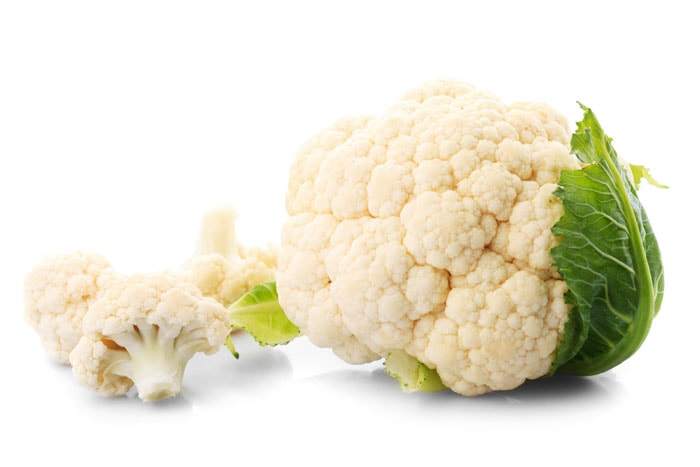
Written By: Sofia Layarda, MPH
Title: Master of Public Health
Alumni: University of California, Berkeley
Last Updated on:

When we talk about eating more fruits and vegetables, what often comes to mind are the brightly colored varieties (hence the reference to eating “the colors of the rainbow”). But white-fleshed fruits and vegetables have their own secrets of the healthful kind. In celebration of Nutrition Month, let’s take a closer look at a white vegetable: cauliflower.
Cauliflower belongs to the same family of cruciferous vegetables as kale, broccoli, and cabbage. While the variety we most often see in stores has a pale, off-white shade, there are colored varieties of cauliflower, such as orange and purple.
Table of Contents
1 cup of cooked cauliflower florets contains:

As far as vegetables go, cauliflower contains many powerful nutrients that act as antioxidants, anti-inflammatory, and detoxifying agents. In particular, cauliflower is high in phytonutrients called glucosinolates, which help activate our own body’s detoxifying enzymes. Cauliflower is also a great source of the well-known antioxidant Vitamin C and the nutrient manganese, which is involved in antioxidant reactions within the body. Add to that the high fiber and low caloric load per serving and you’ve got yourself a deceptively humble nutritional superstar! Studies have linked regular consumption of cruciferous vegetables with decreased incidence of some types of cancer.
When buying cauliflower, look for firmly packed whole “heads” with no brownish or moldy spots. Sometimes cauliflower comes pre-wrapped in plastic, so keep an eye on the florets to make sure there is no moisture developing while in storage. You can keep uncut whole heads in the fridge for about a week. If you buy pre-cut florets, use them within a couple of days because they tend to spoil sooner.
Served raw, cauliflower is crunchy and can have a slightly bitter taste and sharp smell. However, cooking cauliflower completely changes its personality; the texture softens and the sharpness of the flavor gets toned down. Personally, I prefer cooking cauliflower in a stir-fry with lots of garlic and a few dashes of broth instead of boiling or steaming, which leaves the vegetable soggy and fairly tasteless. Another tasty way to enjoy it is to roast the florets in the oven: simply cut into fairly large chunks, toss with a bit of olive oil, salt, and pepper, and roast covered in the oven at 375F for about 45 minutes (or longer, if you prefer a softer texture). Roasting brings out the sweetness of the vegetable and avoids the waterlogged mess from cooking in too much water.
Alumni: University of California, Berkeley – Sofia believes in bringing back fun and pleasure into everyday eating. She loves cooking, and is constantly experimenting with ingredients, creating recipes and trying them out on family and friends. Her latest interest lies in finding realistic and practical ways of environmentally-friendly food/eating habits.
antioxidant, cauliflower, cruciferous, grocery aisle, healthy every month, vegetables, vitamin c